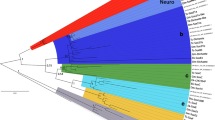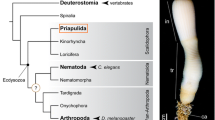Abstract
In vertebrate development the Dickkopf protein family carries out multiple functions and is represented by at least four different genes with distinct biological activities. In invertebrates such as Drosophila and Caenorhabditis, Dickkopf genes have so far not been identified. Here we describe the identification and characterization of a Dickkopf gene with a deduced amino acid sequence closely related to that of chicken Dkk-3 in the basal metazoan Hydra. HyDkk-3 appears to be the only Dickkopf gene in Hydra. The gene is expressed in the gastric region in nematocytes at a late differentiation stage. In silico searches of EST and genome databases indicated the absence of Dkk genes from the protostomes Drosophila and Caenorhabditis, whereas within the deuterostomes, a Dkk-3 gene could be identified in the genome of the urochordate Ciona intestinalis. The results indicate that at an early stage of evolution of multicellularity Dickkopf proteins have already played important roles as developmental signals. They also suggest that vertebrate Dkk-1, 2 and 4 may have originated from a common ancestor gene of Dkk-3.






Similar content being viewed by others

References
Altschul SF, Gish W, Miller W, Myers EW, Lipman DJ (1990) Basic local alignment search tool. J Mol Biol 215(3):403–410
Aravind L, Koonin EV (1998) A colipase fold in the carboxy-terminal domain of the Wnt antagonists—the Dickkopfs. Curr Biol 8:477–478
Bosch TCG (2003) Ancient signals: peptides and the interpretation of positional information in ancestral metazoans. Comp Biochem Physiol (in press)
Bosch TCG, David CN (1987) Stem cells of Hydra magnipapillata can differentiate into somatic cells and germ line cells. Dev Biol 121:182–191
Bosch TCG, Fujisawa T (2001) Polyps, peptides and patterning. BioEssays 23:420–427
Bosch TCG, Khalturin K (2002) Patterning and cell differentiation in Hydra: novel genes and the limits to conservation. Can J Zool 80:1670–1677
Brandon C, Tooze J (1999) Introduction to protein structure, 2nd edn. Garland, New York
Collins AG (1998) Evaluating multiple alternative hypotheses for the origin of Bilateria: an analysis of 18S rRNA molecular evidence. Proc Natl Acad Sci USA 95:15458–15463
Corbo JC, Gregorio AD, Levine M (2001) The ascidian as a model organism in developmental and evolutionary biology. Cell 106:535–538
David CN, Challoner D (1974) Distribution of interstitial cells and differentiating nematocytes in nests in Hydra. Am Zool 14:537–542
David CN, Gierer A (1974) Cell cycle kinetics and development of Hydra attenuata. III. Nerve and nematocyte differentiation. J Cell Sci 16:359–375
Devon RS, Porteous DJ, Brookes AJ (1995) Splinkerettes—improved vectorettes for greater efficiency in PCR walking. Nucleic Acid Res 23–29:1644–1645
Engel U, Pertz O, Fauser C, Engel J, David CN, Holstein TW (2001) A switch in disulfide linkage during minicollagen assembly in Hydra nematocysts. EMBO J 20:3063–3073
Engel U, Oezbek S, Engel R, Petri B, Lottspeich F, Holstein TW (2002) Nowa, a novel protein with minicollagen Cys-rich domains, is involved in nematocyst formation in Hydra. J Cell Sci 115:3923–3934
Glinka A, Wu W, Delius H, Monaghan AP, Blumenstock C, Niehrs C (1998) Dickkopf-1 is a member of a new family of secreted proteins and functions in head induction. Nature 391:357–362
Grens A, Mason E, Marsh JL, Bode HR (1995) Evolutionary conservation of a cell fate specification gene—the hydra achaete-scute homolog has proneural activity in Drosophila. Development 121:4027–4035
Hino K, Satou Y, Yagi K, Satoh N (2003) A genomewide survey of developmentally relevant genes in Ciona intestinalis. VI. Genes for Wnt, TGβ, hedgehog and Jak/STAT signalling pathways. Dev Genes Evol 213(5–6):264–272
Holstein T (1981) The morphogenesis of nematocytes in Hydra and Forskalia: an ultrastructural study. J Ultrastruct Res 75:276–290
Holstein TW, Benoit M, von Herder G, Wanner G, David CN, Gaub EH (1994) Fibrous minicollagens in Hydra nematocytes. Science 223:402–404
Koch AW, Holstein TW, Mala C, Kurz E, Engel J, David CN (1998) Spinalin, a new glycine- and histidine-rich protein in spines of Hydra nematocysts. J Cell Sci 111:1545–1554
Krupnik VE, Sharp JD, Jiang C, Robison K, Chickering TW, Amaravadi L, Brown DE, Guyot D, Mays G, Leiby K, Chang B, Duong T, Goodearl ADJ, Gearing, PD, Sokol SY, McCarthy SA (1999) Functional and structural diversity of the human Dickkopf gene family. Gene 238:301–313
Kurz EM, Holstein TW, Petri BM, Engel J, David CN (1991) Mini-collagens in hydra nematocytes. J Cell Biol 115:1159–1169
Li L, Mao J, Sun L, Liu W, Wu D (2002) Second cysteine-rich domain of Dickkopf-2 activates canonical Wnt signaling pathway via LRP-6 independently of dishevelled. J Biol Chem 277:5977–5981
Liang P, Pardee AB (1992) Differential display of eukaryotic messenger RNA by means of the polymerase chain reaction. Science 257:967–971
Lohmann JU, Bosch TCG (2000) The novel peptide HEADY specifies apical fate in a simple radially symmetric metazoan. Genes Dev 14:2771–2777
Lohmann JU, Schickle H, Bosch TCG (1995) REN display, a rapid and efficient method for nonradioactive differential display and mRNA isolation. Biotechniques 18:200–202
Mao B, Niehrs C (2003) Kremen2 modulates Dickkopf2 activity during Wnt/LRP6 signaling. Gene 302:179–183
Mariscal RN (1974) Nematocysts. In: Muscatine L, Lenhoff HM (eds) Coelenterate biology: reviews and new perspectives. Academic, New York, pp 129–178
Martinez DE, Dirksen ML, Bode PM, Jamrich M, Steele RE, Bode HR (1997) Budhead, a fork head/HNF-3 homologue, is expressed during axis formation and head specification in hydra. Dev Biol 192:523–536
McLysaght A, Hokamp K, Wolfe KH (2002) Extensive genomic duplication during early chordate evolution. Nat Genet 31:200–204
Monaghan AP, Kioschis P, Wu W, Zuniga A, Bock D, Poustka A, Delius H, Niehrs C (1999) Dickkopf genes are co-ordinately expressed in mesodermal lineages. Mech Dev 87:45–56
Mukhopadhyay M, Shtrom S, Rodriguez-Esteban C, Chen L, Tsukui T, Gomer L, Dorward DW, Glinka A, Grinberg A, Huang SP, Niehrs C, Belmonte JC, Westphal H (2001) Dickkopf1 is required for embryonic head induction and limb morphogenesis in the mouse. Dev Cell 1:423–434
Saitou N, Nei M (1987) The neighbor-joining method: a new method for reconstructing phylogenetic trees. Mol Biol Evol 4:406–425
Steele RE, Stover NA, Sakaguchi M (1999) Appearance and disappearance of Syk family protein-tyrosine kinase genes during metazoan evolution. Gene 239:91–97
Szczepanek S, Cikala M, David CN (2002) Poly-γ-glutamate synthesis during formation of nematocyst capsules in Hydra. J Cell Sci 115:745–751
Tardent P (1995) The Cnidarian cnidocyte, a high-tech cellular weaponry. BioEssays 17:351–362
Acknowledgements
We thank Konstantin Khalturin for help with the in silico analysis and him and Ulrich Technau for discussion and critically reading the manuscript. Supported by the Deutsche Forschungsgemeinschaft.
Author information
Authors and Affiliations
Corresponding author
Additional information
H. Fedders and R. Augustin contributed equally to this work
Edited by D. Tautz
Rights and permissions
About this article
Cite this article
Fedders, H., Augustin, R. & Bosch, T.C.G. A Dickkopf-3-related gene is expressed in differentiating nematocytes in the basal metazoan Hydra . Dev Genes Evol 214, 72–80 (2004). https://doi.org/10.1007/s00427-003-0378-9
Received:
Accepted:
Published:
Issue Date:
DOI: https://doi.org/10.1007/s00427-003-0378-9



